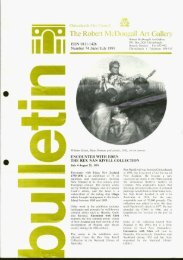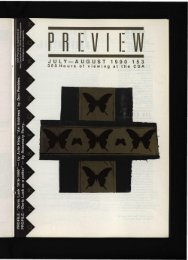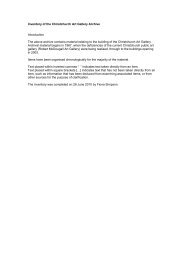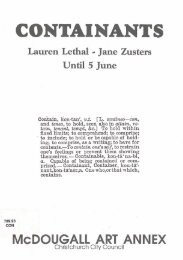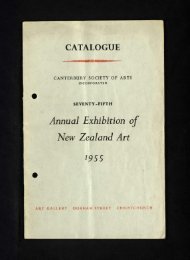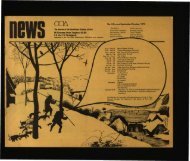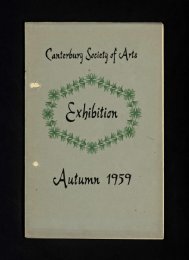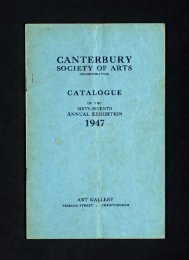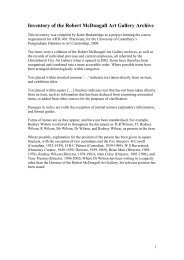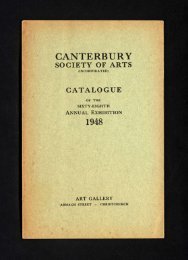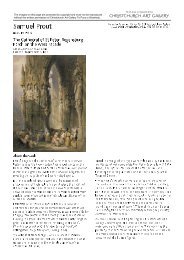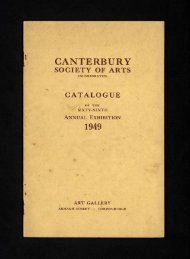Download - Christchurch Art Gallery
Download - Christchurch Art Gallery
Download - Christchurch Art Gallery
Create successful ePaper yourself
Turn your PDF publications into a flip-book with our unique Google optimized e-Paper software.
am<br />
The journal of the Canterbury Society of <strong>Art</strong>s<br />
66 Gloucester Street Telephone 67 261<br />
PO Box 772 <strong>Christchurch</strong> New Zealand<br />
<strong>Gallery</strong> Hours Mon-Fri 10 am —4.30 pm<br />
Sat-Sun 2.00 — 4.30 pm<br />
Number 112 Nov/Dec 1983<br />
Patron<br />
Society Officers<br />
The Hon. Sir David Beattie<br />
G.C.M.G., Q.C.<br />
President<br />
Vice Presidents<br />
Mrs Doris Holland<br />
John Trengrove, Dip. Arch., F.N.Z.I.A.<br />
John Coley, Dip.F.A., Dip.Tchg.<br />
Michael Eaton, Dip.F.A., Dip.Tchg.,<br />
F.R.S.A.<br />
W. W. Cumming<br />
Derek Hargreaves, B.Com., A.C.A.<br />
Simon Stamers-Smith, LL.B.<br />
Council<br />
Director<br />
Hon. Secretary<br />
Hon. Treasurer<br />
Auditor<br />
Judge Fergus Paterson<br />
Nola Barron<br />
John Vial, Dip.Arch.<br />
Jewel Oliver<br />
Jill Dando<br />
John Hurrell, B.A., Dip.F.A.<br />
David Sheppard, M.Arch.,<br />
M.C.P.(Penn.), A.N.Z.I.A.,<br />
M.N.Z.P.I., R.I.B.A.<br />
Michael Ebel<br />
Nola Barron<br />
Pat Delaney, A.C.A.<br />
John Wilson, A.C.A.<br />
W. J. Parsons, B.Com., A.C.A.<br />
<strong>Gallery</strong> Assistants Grant Banbury, Dip.F.A.(Hons.)<br />
Evan Webb, Dip.F.A.(Hons.)<br />
Delia O'Callaghan<br />
Receptionist<br />
Tutors<br />
Rona Rose<br />
Michael Ebel<br />
Nan Crawley, Dip.F.A.<br />
James Bruce, Dip.F.A.<br />
Alan Smith, Dip.F.A.<br />
RIPPLES<br />
by Rick Edmonds<br />
Editor<br />
Josie Jay<br />
Registered at Post Office HO Wellington as a<br />
Magazine
PRINTS-<br />
FRAMING...<br />
RESTORING<br />
For Selection...<br />
FISHERS<br />
ART DEALERS SINCE 1870<br />
ORIGINALS...<br />
We offer a COMPLLTL SERVICE<br />
SELLING BUYING VALUATIONS<br />
EXPERT CLEANING<br />
GILDING AND ANTIQUE<br />
RESTORING<br />
H. FISHER & SON LTD<br />
Fine <strong>Art</strong> Dealers 691 Colombo Street<br />
(Between Ca»hel ft Hereford Street*)<br />
Annual General Meeting<br />
Wednesday, November 23<br />
at 7.45 p.m.<br />
Members are encouraged to come to<br />
this meeting for, after the short business<br />
procedure, John Hurrell, B.A., Dip.F.A.<br />
will speak of his recent trip to Australia as<br />
holder of the CSA Guthrey Award.<br />
Sherry will be served.<br />
"Showcase"<br />
In our new reception area members will have noticed<br />
the glass show-case containing choice small pieces of<br />
jewellery, ceramics, woodware, boxes, cards, and<br />
calendars by New Zealand artists.<br />
We hope you will be able to discover here the perfect<br />
solution to your gift problems.<br />
Membership<br />
Members will have received their accounts for 1983-84<br />
season and we are pleased that many have paid<br />
promptly. This greatly eases the task for office staff in<br />
reducing the number of reminder notices and<br />
accounts rendered that need to be sent.<br />
Many thanks.<br />
Selection for Working<br />
Membership<br />
The next selection date for those wishing to submit<br />
work will be March 13, 1984.<br />
CSA Summer Exhibition<br />
Working members of the Society may present two<br />
works for the Summer Exhibition on Receiving Day<br />
—December 5.<br />
All Members and Friends are invited to the preview at<br />
8 p.m. on December 8.<br />
Landscape Painting Group<br />
Last meeting Saturday November 19, Prices Valley, at<br />
10 a.m. Please ring — Lynda Mallard 31-388.<br />
Assistance required<br />
The Society and the artists are greatly dependant<br />
upon the help of volunteers for several important jobs<br />
— recording sales and for serving wine at previews,<br />
and for folding the newsletter ready for postage.<br />
We are very grateful to those who quietly go about<br />
their duties and provide a much appreciated service in<br />
the background.<br />
Mrs Jewel Oliver has a small reliable band of hostesses<br />
whom she musters, but would like more helpers to<br />
ease the burden on the few, to pour the wine and<br />
repack the boxes at the end of the evening.<br />
If you are willing to help with the NEWSLETTER<br />
FOLDING or with SALES TABLE or SERVING WINE<br />
at some previews, we would be delighted to hear from<br />
you — please ring 34-038 Mrs Oliver or the office —<br />
67-261.<br />
Recent Purchases<br />
The Westpack Banking Corporation Wellington has<br />
commissioned through the CSA <strong>Gallery</strong> a woven<br />
hanging by John Hadwen and are considering a glass<br />
mural by Tony Kuepfer.<br />
The National <strong>Art</strong> <strong>Gallery</strong> Wellington is to purchase the<br />
sculpture installation recently exhibited in the Mair<br />
<strong>Gallery</strong> by Pauline Rhodes.
Children's <strong>Art</strong> Classes —<br />
Exhibition<br />
An exhibition of work done in the childrens art classes<br />
will be on view from Saturday afternoon, December<br />
10, from 2 p.m., until December 18. This term the<br />
tutors have been Nan Crawley, James Bruce and Alan<br />
Smith.<br />
We thank them for their good work with the children<br />
and for the enthusiasm and understanding generated<br />
in their classes. Parents and children are reminded of<br />
their preview at 11.15 p.m. on Saturday, December 10.<br />
Enrolments can be taken now for the morning Childrens<br />
<strong>Art</strong> Workshops, Tuesday January 25-Friday 27<br />
and for Term 11984 classes which commence February<br />
11, 1984 — Phone 67-261.<br />
Otago Summer School<br />
January 6-12,1984<br />
Classes in Batik, Drawing, Painting, Printmaking,<br />
Stained Glass.<br />
Write for brochure and details of accommodation to:<br />
Continuing Education Unit,<br />
Otago University Extension,<br />
P.O. Box 56,<br />
Dunedin.<br />
Are you a Business Firm?<br />
Corporate Member — $150 a year<br />
This entitles your firm to:<br />
(1) Three "double" membership season cards for free<br />
admission to Society exhibition and invitation to<br />
previews.<br />
(2) Additional invitations for visiting executives on<br />
request.<br />
(3) Pre-opening buying of one work for your offices<br />
from Society exhibitions.<br />
(4) Borrow one work from the Society's hire collection<br />
of original paintings changed in May and<br />
November.<br />
(5) Advice on purchases and commissioning of art<br />
works for your premises.<br />
(6) Free Newsletter and invitation sheet bi-monthly.<br />
(7) Participation in the annual art union.<br />
From the wide selection of exhibitions — over 90 a<br />
year you will find a great many that will enliven and<br />
inform the interest of your executives and staff. Not<br />
only does this entitlement benefit them, your valued<br />
support assists the Canterbury Society of <strong>Art</strong>s in its<br />
aim to foster the visual arts in Canterbury.<br />
r<br />
Fine Jewellery<br />
IN GOLD AND SILVER<br />
by<br />
Gucntcr Taemmler<br />
- MASTER GOLDSMITH -<br />
CSA <strong>Gallery</strong> 66 Gloucester Street<br />
CARINA Jewellers, 15 Chancery Lane,<br />
MERIVALE<br />
VILLAGE<br />
FLORIST<br />
Ruth Bain<br />
Diploma N.Z.P.F.<br />
CHRISTCHURCH<br />
Shop 4<br />
Merivale Mall<br />
Papanui Road<br />
Telephones 559-738<br />
After Hours<br />
557-253 or 528-577<br />
MALING & CO<br />
The drawing from Michael Ebel's recent exhibition at<br />
the <strong>Gallery</strong> "It all looks good on paper and the twelve"<br />
is travelling to Greymouth to be exhibited in the New<br />
<strong>Gallery</strong> at the Borough Council building from October<br />
29-November 11.<br />
WINE MERCHANTS<br />
86 GLOUCESTER STREET<br />
795-470
Cashmere <strong>Gallery</strong><br />
12 Colombo Street<br />
at the foot of the hills<br />
for<br />
Pottery by N.Z. Exhibition Potters<br />
Paintings, Jewellery, Handcrafts, Lamps<br />
BEALEY GALLERY<br />
Quality Picture Framing<br />
Exhibition Pottery<br />
Christies Contemporary <strong>Art</strong><br />
Director: John Simpson<br />
Telephone 67-506<br />
Private 583-351<br />
59 Victoria St<br />
P.O. Box 25045<br />
Victoria St <strong>Christchurch</strong><br />
ARTISTS<br />
CHOOSE FROM OUR VERY WIDE<br />
RANGE OF COLOURS, BRUSHES,<br />
BOARDS, PAPERS AND<br />
ACCESSORIES.<br />
Please ring for information or call at<br />
213 Tuam St Phone 791-080<br />
ISmlth § Smith.<br />
PUBLICITY with PANACHE<br />
Talking with various members of our society there<br />
seems to be a need for more publicity. Several people<br />
having expressed the desire for publicity outside the<br />
<strong>Gallery</strong> to create more interest within it, be encouraging<br />
the participation of the public through more exciting<br />
and flamboyant promotion of the arts.<br />
The <strong>Gallery</strong> regularly advertises exhibitions through<br />
the newspapers, but the aim of this article is to find<br />
ways to attract the attention and gain the patronage of<br />
"would-be" arts supporters.<br />
Suggestions put forward so far are:<br />
Tours of the <strong>Gallery</strong> to invited groups such as Rotary,<br />
people from big companies and firms, etc, for a talk on<br />
the functions of the <strong>Gallery</strong>, as practised in many<br />
overseas galleries.<br />
Inviting a colourful personality to open an exhibition.<br />
Seeking permission to use the wall opposite the<br />
<strong>Gallery</strong> (previously the Air N .Z. freight depot) to advertise<br />
the <strong>Art</strong>s (even if it means re-painting it afterwards).<br />
Posters around the City. Various entertainment events<br />
at openings, e.g. dancers, live music and debating,<br />
etc.<br />
The <strong>Gallery</strong> is happy for the exhibiting artists to organise<br />
this where appropriate, and to remind members<br />
that there is a grand piano available for anyone who<br />
wishes to play it.<br />
Appoint a Publicity Officer.<br />
A coffee bar serving food with "flair" — perhaps — on<br />
the mezzanine floor with half of it carpeted for a lounge<br />
with easy chairs and music — 50 can look out into the<br />
Mair gallery.<br />
Other ideas suggested are:<br />
A life drawing class (in the print room?)<br />
We would like more response by members (viewers)<br />
to the works shown in the <strong>Gallery</strong> to give the artists<br />
some feed-back on how their work affects the public.<br />
Members could actively encourage their friends to<br />
become interested in the <strong>Gallery</strong>, to join and to purchase<br />
art works.<br />
Members could also encourage the news media to<br />
give greater coverage of the arts and more reviews in<br />
the papers.<br />
If you agree/disagree, have other ideas, or can assist<br />
in any way, please write and air your views.<br />
This is your chance!<br />
The President's Exhibition<br />
A note to tell artists and members how pleased I am<br />
that this exhibition fulfilled beyond my expectations<br />
the potential variety and abundance of ideas hoped for<br />
when the show was conceived.<br />
Above all, to have so many fine artists, both in <strong>Christchurch</strong><br />
and elsewhere, submit work for this exhibition,<br />
proved that the theme had very wide appeal in allowing<br />
inventive practices in terms of the media to have<br />
very personal interpretation.<br />
This has been one of our most successful exhibitions,<br />
and I hope that the lively and original works will be<br />
enjoyed by aspiring artists and visitors.<br />
Doris Holland
A cooperative of craftspeople<br />
Upstairs in The Shades<br />
for exclusive weaving<br />
pottery<br />
wood turning<br />
fabric crafts<br />
silver jewellery<br />
sketches<br />
The <strong>Gallery</strong> is interested in handling<br />
the re-sale of early paintings and has<br />
collectors inquiring for such work.<br />
Please enquire at the office.<br />
C.S.A. GALLERY<br />
Antiques 1<br />
2U KAUSe -<br />
IK VGRTR AUT&O VJO<br />
&e«.BSWERSTAC)ODi-lCMK.ClT U/ur>siCH6RHElT HERItSCHT.<br />
llJ DERFCRAJC.-<br />
IH FREMDCXJ. vjJO<br />
das uene u>Lo dgr zajfall. Au_oecewuJAERTic> vsr.<br />
SStM&eaBAJ,<br />
two zustabajwlaJ.<br />
SOVOA&VJJIG- MerA"0(?PlAOS£ODeiST , R02£.&S.<br />
Text sy zyacy<br />
AT none -<br />
FAMILIARITY, . ,<br />
that coes vajithowt sAyiAJQ, sccuRiry >i law,<br />
OUT THERE DISTAOT -<br />
PORei ovo,<br />
Al_\icto»o.<br />
T=ROH Trt€. PAST i^rrO TVtfc TRESeOT.<br />
FRD" 6^t€ SGCOWD l-JTO TM£TWRB OIMEAJSIOM.<br />
2one-niioaciice-MerAMOR.piios.is oR-pooce&s.<br />
TioVOscATe-ni3y i^u'«o£x> vJAifteC<br />
Genuine and Professionally<br />
ualified Antique Restorers and<br />
Sealers are themselves very rare in<br />
New Zealand.<br />
But there is one such firm in<br />
<strong>Christchurch</strong>.<br />
They are John Morrison and<br />
his son Ross who are top of<br />
the tree in their unique<br />
profession. Bot h John and<br />
Ross would welcome you to<br />
visit them at work and<br />
answer your questions on<br />
antiques and show you some<br />
of the magnificent piece:<br />
they have.<br />
CALL NOW<br />
OR PHONE 790-408<br />
><br />
lolrn Jf. ittorrisrm<br />
& Son<br />
of Victoria Antiques<br />
8 LIVINGSTONE STREET<br />
(Off Fitzgerald Ave, between Lichlield Ave and Tuam St >>y
WINDSOR GALLERY LTD<br />
(FORMERLY SMITH & HODGSON)<br />
OUR NEW GALLERY IS THE MOST<br />
SPACIOUS IN CHRISTCHURCH<br />
QUALITY PICTURES ARTISTIC FRAMING<br />
153 HIGH STREET<br />
(OPP. HURST & DRAKE) PHONE: 60-724<br />
ROWNEY<br />
Top Quality<br />
<strong>Art</strong>ists Materials<br />
Oil Colours, Water Colours, Acrylic Colours,<br />
Brushes, Palettes — Everything for the <strong>Art</strong>ist<br />
MANUFACTURERS OF ARTISTS MATERIALS<br />
SINCE 1783<br />
CFM SHftCKEL<br />
GIVES YOU THE BEST FOR<br />
MEATS<br />
LESS<br />
WHOLESALE PRICES<br />
ON YOUR COMPLETE MEAT<br />
REQUIREMENTS<br />
LOCATIONS<br />
72 New Brighton Mall<br />
248 Lichfield St<br />
Riccarton Mall<br />
Countdown, Northlands<br />
Meat Market, Belfast<br />
LATE NIGHTS<br />
Saturday<br />
Tuesday<br />
Thursday<br />
Friday<br />
Thursday<br />
The Properties of Acrylic<br />
Colours and How They Affect<br />
<strong>Art</strong>ists' Technique<br />
Acrylic colours, very much a product of the 20th century,<br />
consist of resin, pigments and a wide range of<br />
additives. The significance of the additives lies in their<br />
control and stability. The nature of the resin being of<br />
the major significance. The base is a chemical caled<br />
Methyl Methacrylate produced by the Petrochemical<br />
Industry. Methyl Methacrylate is a colourless liquid<br />
and like many other organic liquids has a characteristic<br />
pungent odour. Unlike the common solvents, however,<br />
it has the ability to react chemically with itself to<br />
produce resins. The process is most easily understood<br />
by imagining a series of chains built from may<br />
links. The link is Methyl Methacrylate and the chains<br />
acrylic polymer or resin. One can obtain chains of<br />
varying lengths or, as the chemist would say, polymers<br />
of varying molecular weight, and this is a factor<br />
which will effect the properties of the resin. To be<br />
suitable as a paint, shorter chain lengths are needed,<br />
even so the polymer would give paint films which<br />
would be too brittle. It is therefore necessary to add a<br />
softener or plasticiser. This method consists of adding<br />
a liquid to the resin which will dissolve it and which will<br />
not subsequently evaporate. This is described as an<br />
"externally plasticised resin" which unfortunately<br />
suffers from several defects. The most obvious is that<br />
despite the intention the liquid will gradually evaporate<br />
and the paint thus become brittle with age. The technically<br />
more complicated method of "internally plasticising"<br />
the resin results in a more permanent paint. The<br />
easiest way to picture this process is to think of introducing<br />
specially soft links into the chains during<br />
manufacture. Chemically fixed in this manner there<br />
can be little change of subsequent embrittlement.<br />
Consequently a high quality acrylic colour such as<br />
Rowney Cryla is based on this type of resin. Unfortunately<br />
acrylic resins of this type when made by conventional<br />
methods are only soluble in very powerful<br />
organic solvents. As a result paints made from them<br />
could only be used in specially ventilated areas. This<br />
problem has been overcome by developing an alternative<br />
method of manufacture known as "Emulsion<br />
Polymerisation". This process, which gives the names<br />
"polymer emulsion", "emulsion paint", etc., consists of<br />
producing discreet small particles of resin, each established<br />
in water. Thus the resin readily mixes with water<br />
but is never dissolved in it. The polymer dispertion is<br />
partly opaque which distinguishes it from most true<br />
solutions, but the degree of opacity will depend on a<br />
number of factors which must be considered from the<br />
acrylic resin, and this explains why not all acrylics<br />
necessarly have the high qualities which can be associated<br />
with the better acrylic products. As the resin<br />
dries water evaporates from the film and the white<br />
colour disappears. The dispersion has now been<br />
broken and the resin can no longer be mixed with<br />
water. Once all the water has left the resin film no<br />
further changes take place. The drying time is a few<br />
minutes which is very short compared to that of oil<br />
colour. In very humid weather, drying time can be very<br />
substantially increased. Temperature will also have<br />
some effect but unlike oil colour which undergoes a<br />
light affected chemical reaction during drying, acrylics<br />
are unaffected by drying in darkness. As the water<br />
evaporates from the film, there is a change in the<br />
Refractive Index and when this is combined with the<br />
loss of whiteness of the resin it follows that there will<br />
always be a slight darkening in colour during drying.<br />
In the best acrylics this is minimised by using a good<br />
resin and working at a high pigment level. In contrast<br />
with oil colour there are no further changes after the<br />
first few minutes of drying, thus, whilst it is necessary<br />
for the artist to allow for a small initial change of colour<br />
he need have no fear of subsequent yellowing or the<br />
gradual increase in transparency which occurs with oil<br />
colours. The acrylic resin film is very flexible and will<br />
not embrittle with increasing age. It is also very resistant<br />
to the components in the atmosphere and because<br />
of this it is expected to be very permanent — more so<br />
than oil based films, and accelerated ageing tests confirm<br />
this is the case, however, we must wait a further<br />
200 years to be really sure.<br />
Some of the traditional pigments are missing from the<br />
acryli colour range. There are a number of technical<br />
reasons why this is so. The acrylic resin is most stable<br />
in the alkaline phase. Some pigments, notably Alizarin<br />
Crimson and Prussian Blue, react with alkali, others,<br />
t
ecause of their method of manufacture contain water<br />
soluble salts which affect the stability of the resin and<br />
therefore cannot be used. Yet other pigments which<br />
fade in the medium of gum arabic are permanent when<br />
mixed with acrylic, even when diluted hevily with<br />
water.<br />
One problem area lies in the resistance of cold water.<br />
Most dispersion polymers are sensitive to freezing and<br />
acrylics are no exception. This can be overcome in the<br />
paint, and a product such as Rowney Cryla can be<br />
frozen and thawed many times without deliterous<br />
effects. It is less easy to overcome the problem during<br />
the application of the paint and minimum Film Forming<br />
Temperature is sufficiently close to freezing point<br />
to prevent artists experiencing problems.<br />
In 1963 Rowney launched Cryla, the first tubed acrylic<br />
colour specially intended for artists. Some problems<br />
lay ahead but the outstanding permanence, speed of<br />
drying, the ease of use of water based materials and<br />
the adhesive properties were such that the work<br />
needed to overcome the difficulties was bound to be<br />
worthwhile.<br />
The - most clear-cut advantage of acrylics over oils is<br />
their rapid dry. Paintings which might formerly have<br />
taken weeks or even months can be completed in<br />
days. It is possible to paint out of doors in order to<br />
achieve the freshness and spontaniety normally associated<br />
with watercolours and half an hour or so after<br />
the last brush stroke, roll the canvas in tissue and take<br />
it home. It is not possible to apply the paint, give the<br />
work the mature consideration and if dissatisfied<br />
scrape the paint off. With acrylics rectification must be<br />
achieved by painting over the area in question. There<br />
are no rules as to when one may overpaint. If it is dry —<br />
fine! Paint on! Not surprisingly the Cryla Standard<br />
Formula, as the first product is now called, was<br />
designed to look and feel like oil colour. The consistency<br />
and brushing qualities are very similar. The knifing<br />
qualities are even better, as there is less tendency<br />
to string from the knife and all colours behave similar<br />
to one another. For heavy impasto textures it is unsrupassed<br />
and leaves crisp edges. The speed of dry,<br />
particularly thorough dry, means that even the heaviest<br />
application will dry overnight or at the worst in a<br />
day or two, without the tendency to crack or wrinkle.<br />
Acrylic colour may be used to achieve similar appearance<br />
to that usually associated with oil colours. Used<br />
direct from the tube the colour tends to be opaque and<br />
is usually necessary to increase the transparency by<br />
diluting with a little water or medium. The medium is<br />
essentially the unpigmented resin and its addition to<br />
the colour increases gloss. For this reason it is known<br />
as Gloss Medium. Matt Medium does not produce the<br />
gloss to the colour but leaves it sensibly unchanged as<br />
the transparency increases. These mediums can be<br />
intermixed in any proportion if so desired, whilst many<br />
of the standard techniques of oil painting can be used.<br />
If glazing techniques are to be used then the most<br />
suitable additive is Glaze Medium No. 3 which has<br />
much less effect on the consistency of the paint. By<br />
simply diluting further with water many watercolour<br />
painting effects can be achieved. It is however important<br />
to note, that if the colour is extremely dilute the<br />
resin will not form a sufficiently thick film to fully<br />
protect the pigment and thus permit overpainting<br />
without effecting earlier layers. This may not be significant<br />
if true water colour techniques are being used.<br />
The problem can be avoided by diluting with a mixture<br />
of water and medium. With acrylics there is a greater<br />
tendency for the pigment to granulate thatn occurs in<br />
Gum Arabic based colours. For this reason some<br />
watercolourists paint the stronger colours first in<br />
acrylic and then paint the thinner wash areas in water<br />
colour.<br />
To be continued in next issue.<br />
For an exclusive and very different decor for your<br />
home or commercial interior, do call and browse<br />
amongst our imported fabrics, handprint wallpapers,<br />
lamps and accessories.<br />
A complete interior<br />
decorating service from<br />
lighting to custom<br />
made lampshades is<br />
available.<br />
DESIGN & DECOR<br />
7 St. Albans St.<br />
Merivale. Tel. 554-6 79<br />
ART SERVICES<br />
LTD.<br />
PICTURE FRAMING<br />
PHONE 68-429<br />
241A MANCHESTER STREET<br />
RING, WRITE OR CALL FOR<br />
PROfVPT, COURTEOUS ATTENTION<br />
EXPERT CRAFTSMANSHIP AT<br />
REASONABLE PRICES<br />
WE WILL CLEAN, RESTORE AND<br />
REFRAME OLD PICTURES<br />
P.O. BOX 13356 ARMAGH
Property Owners! When selling consult<br />
Views and Reviews<br />
IMiTltUll<br />
N.I.<br />
Don Peebles<br />
talks on his trip to New York<br />
AUCTIONEERS & REAL ESTATE AGENTS<br />
133 WORCESTER STREET, CHRISTCHURCH<br />
¥r]E<br />
in Campbell Grant<br />
P3CTQRE §1}0P<br />
196 Hereford Street, <strong>Christchurch</strong><br />
ARTISTS - have your pictures framed in our<br />
specialist shop (near Latimer<br />
Square) Large range of Mouldings<br />
10% discount for C.S.A.<br />
Members.<br />
^ Ritehi^Finetlrts ^<br />
PICTURE OflLLERY<br />
SPKC IM.ISIS IN KARI.Y MW/I ALAND.<br />
\ISTRAU\N.& II ROHAN ART<br />
EXflffilTIOn<br />
I'LKM W I N I<br />
• ALL FOR SALE<br />
• WE POST OVERSEAS<br />
• HOURS-MON.-FRI.9am-5-30pm<br />
• MINUTES AWAY-FOLLOW MAP<br />
72<br />
Noahs o<br />
^on River<br />
GALLERY<br />
72 GLOUCESTER ST.<br />
CHRISTCHURCH N.Z. ^»<br />
"The pioneers create through their reaction to external<br />
stimuli. They are guided not by the mass but by that<br />
which they see and feel. They discover consciously or<br />
unconsciously the fundamental laws hidden in reality,<br />
and aim at realising them. In this way they further<br />
human development. They know that humanity is not<br />
served by making art comprehensible to everybody; to<br />
try this is to attempt the impossible. One serves mankind<br />
by enlightening it."<br />
— Piet Mondrian —<br />
Report: Josie Jay<br />
Don gave a talk and showed slides of his trip to New<br />
York at the McDougall <strong>Art</strong> <strong>Gallery</strong> on September 21.<br />
The purpose of Don's study leave was to visit important<br />
overseas collections and talk with artists in the<br />
New York area. New York, being the leader in the<br />
visual arts, has the greatest number of ambitious<br />
artists working and exhibiting. Informed criticism is<br />
also well established.<br />
This was Don's third and longest visit which gave him<br />
the opportunity to view many major collections such<br />
as at the Metropolitan, Whitney and Modern <strong>Art</strong><br />
Museum, but the highlights of his trip were visits to the<br />
many Dealer Galleries and talking with artists in their<br />
studios, which he regarded as a privilege.<br />
The fault of major museums, he felt, was the tendency<br />
to offer too much, which was difficult to digest, whereas<br />
the smaller, more intimate museums, provided a<br />
relief.<br />
With only four months leave, Don decided to concentrate<br />
on work produced during the 19th and 20th centuries.<br />
He was fortunate to gain admittance to the<br />
Rothko Foundation where he was able to study the<br />
whole spectrum of Mark Rothko's work — from his<br />
earliest life drawings to his last unfinished painting.<br />
Don spent some time at the New York Studio School<br />
of <strong>Art</strong> which is one of the most prestigious art establishments<br />
in the world. He said that "if teaching art is<br />
possible, this school has managed to set up conditions<br />
uniquely conducive towards it".<br />
At Long Island he visited Project Studio One, the institute<br />
for <strong>Art</strong> and Urban Resources, and saw a large<br />
array of art produced during the 1960s.<br />
I
The Dealer's Galleries that left a strong impression<br />
were often ones that exhibited work by artists he was<br />
surprised but pleased to see together, such as work by<br />
Egon Schiele with his intensely expressionistic and<br />
often erotic style, and Henry Matisse, with his calm,<br />
classically spare line, and untroubled subject matter,<br />
but both artists sharing a superbly elegant way with<br />
drawing.<br />
The exhibition of works by Mondrian and Brancusi at<br />
the Sidney Janus <strong>Gallery</strong> was another combination of<br />
artists Don found rewarding.<br />
The Guggenheim Museum showed an exhibition of<br />
Yves Klein — a precursor of much modern art, and<br />
Don was most impressed by a work painted in the<br />
famous and patented International Klein Blue, which<br />
he thought magnificent, radiating light.<br />
The artists Don met included Max Gimlet and Bill<br />
Alpert with whose work he felt a great empathy; and<br />
Peter Wareing, a recent Canterbury Honours student<br />
working in a neo-expressionist style. Gretchen<br />
Albrecht was also working in New York and on her<br />
introduction he visited the Exeter Press where she was<br />
working on hand-made paper.<br />
Don was moved by the commitment to work and<br />
seriousness of so many of the artists in New York.<br />
It was interesting to observe how artists were influenced<br />
by their environment, and the response which<br />
was seen in their work.<br />
Don said that of the new art being produced, two<br />
tendencies were strongly apparent — one being in<br />
exploring an aspect of abstraction where the artists<br />
share the belief that by eliminating the traditional pictorial<br />
devices of realism and figurative references, they<br />
can explore paint with more emotive force; and the<br />
other being a neo-expressionist type of painting which<br />
has emerged as a broad phenonomen.<br />
Not all the New Image work was abstract. There<br />
seemed to be a return to some figurative or narrative<br />
imagery, but one thing was common to all which was a<br />
concern for the way in which the paint was applied.<br />
There was a trend towards a return to oil paint.<br />
The impression felt most powerfully was that New<br />
York was a city of contrasts; from the neighbourhood<br />
or street artist to the Museum of Modern <strong>Art</strong>; from<br />
galleries filled with works to another exhibiting only<br />
one work; the contrast of modern and historic architecture;<br />
from street music by day to a syncopated jazz<br />
rhythm by night; the contrast of people moving about<br />
the city, to sculptural works, particularly those of Charles<br />
Simmonds who sculpts small dwellings for an<br />
imaginary civilisation of "Little People". These are<br />
often placed in unexpected situations so they are protected<br />
from thoughtless acts by larger people.<br />
During his talk Don repeatedly referred to the graffiti<br />
around the city — particularly on the subway, inside<br />
and outside the trains were covered in it; on trucks, the<br />
sides of buildings, in doorways, on billboards — all<br />
very lively and colourful splashes on multifarious surfaces<br />
with a wealth of imagery — perhaps, as one New<br />
York writer claims, the new art, but certainly with an<br />
exciting awareness of a very human presence in it.<br />
Don mentioned the worth of exploring both good and<br />
bad art, in that the good confirms our theories, while<br />
the bad may expand our ideas.<br />
<strong>Art</strong>ists are fortunate now, he said, in that they have<br />
freedom to explore without the constraints that were<br />
imposed (by institutions) as in the 50s and 60s.<br />
By day and night New York proved to be a most<br />
stimulating city and Don could see how people like<br />
Mondrian were inspired. Although it has a population<br />
of 10 million people, which was cramped, he did not<br />
feel claustrophobic because the eye was able to<br />
explore spaces up and down with their multitudinous<br />
features.<br />
This talk was organised by the Friends of the<br />
McDougall <strong>Gallery</strong>, charging an entry fee of $1.50<br />
which goes into an acquisition fund. Talks are held<br />
monthly.<br />
jfrush n-palelfj<br />
BELLS ARCADE<br />
CASHEL STREET<br />
Available<br />
arlisTs<br />
supplies<br />
\<br />
John Rooney<br />
Phone 63-088<br />
at<br />
G.B.D. PRINTS LTD<br />
207 Cashel St. (Opp; The Farmers)<br />
Telephone 60 033<br />
A comprehensive range of artists' materials:<br />
Acrylic, oil & water colours, brushes, papers,<br />
drawing blocks, easels, mounting boards and art<br />
accessories.<br />
SEVERAL ARTS<br />
807 COLOMBO STREET, CHRISTCHURCH<br />
TELEPHONE 69-264<br />
GALLERY FOR EXHIBITIONS<br />
WEAVING AND SPINNING SUPPLIES<br />
HOME Of FINEST POTTERY<br />
SHIRLEY and GRAHAM INWOOD
vexWibiti<br />
Royce McGlashen<br />
Nelson Potter<br />
Exhibition until November 20<br />
Barbara Eaton — Exhibition<br />
Preview November 8, 8 p.m.<br />
Painting has been a hobby for years. I love a wide vista<br />
therefore panaramas appeal. As peace and stillness,<br />
form and line, colour and light mean the most to me I<br />
try for my feeling for a place to come through the<br />
painting rather than adhere strictly to what is there.<br />
The Guild of Woodworkers —<br />
Canterbury<br />
Preview, November 9 at 8 p.m.<br />
Exhibition until November 20<br />
The Guild of Woodworkers is a group of some 50<br />
craftspeople both full- and part-time, whose object is<br />
to encourage a high level of performance in woodwork<br />
in all its aspects and related fields of design. Some of<br />
these members have a lifetime of experience in their<br />
fields, others have more recently taken up the craft.<br />
All, however, have the highest standards of workmanship<br />
and design as their goal. The Guild meets regularly<br />
to discuss and criticise each others work, and<br />
this, as well as the promotion of exhibitions of selected<br />
work, ensures that the quality of members' work is<br />
consistent.<br />
It should be emphasised in these times of massproducted<br />
mediocrity, that these are individual craftspeople<br />
who, in most cases work alone from start to<br />
finish of each job, giving of themselves in the process.
Hot Glass<br />
from November 22<br />
Peter Raos B.F.A. 79from Elam. Helped Mel Simpson<br />
set up glass studios here and then formed partnership<br />
with Peter Viesnik. Both exhibited in the North Island<br />
and been included in travelling group shows but this is<br />
their first venture into the South.<br />
Roas says—"Glass blowing is a combination of<br />
intense, immediate and direct interaction between<br />
artist and material. It is complicated by the battle<br />
between physical limitations and spiritual aspirations.<br />
"The variables in glass forming flow so closely<br />
together they fuse into a spontaneous whole, which<br />
we call the OBJECT: and, OBJECT means an IDEA."<br />
Ripples — Rick Edmonds<br />
Preview, December 8 at 8 p.m.<br />
As a lot of my time is spent on the sea, it is only natural<br />
that I should draw upon it as a major source of inspiration<br />
for my work. Water is a fascinating subject, which<br />
is ever-changing and unstable in mood. It has the rare<br />
distinction of being both reflective and transparent.<br />
This exhibition is a series of studies of some surface<br />
qualities of water. Each work is conceived in purely<br />
abstract terms; colours, tonal variations, textures,<br />
composition, and so on, are carefully considered and<br />
controlled. The two painterly qualities of hard edge<br />
and soft focus are used to show different water surface<br />
effects, be it changes of light, texture or plane.<br />
In most works, these changes are brought about by a<br />
disturbance upon the water itself. Thus in each work a<br />
presence is felt alien to the natural state of the water; a<br />
hint of some moving body, now gone, whose disturbance<br />
is still present. Man's interference with a natural<br />
state: Ripples.<br />
Peter Gibbs (nelson)<br />
Exhibition Preview<br />
December 8, 8 p.m.<br />
Works in salt glaze stoneware and pit-fired porcelain.<br />
Merit Award Fletcher Brownbuilt 1979.<br />
Received <strong>Art</strong>s Council Grant in 1983.<br />
John and Mary Turner<br />
"Wild Pumpkin"<br />
level.<br />
90 * 100 cm pure tufted wool single<br />
Tufted rugs and wall hangings—a further range of<br />
designs exploring organic form and pattern in handdyed<br />
pure wool.<br />
John Turner — Sculpture<br />
From December 20,1983-<br />
January 22,1984<br />
A small selection of pieces, mainly ceramic, reflecting<br />
my current interest in the assembly of, and the relationship<br />
between, several materials.<br />
Rowney Year "200"<br />
This year marks 200 years of active participation in the<br />
manufacture and world-wide distribution of quality<br />
Rowney <strong>Art</strong>ist Materials. The following article supplied<br />
by George Rowney and Company will no doubt be<br />
of interest to both active artist and art enthusiasts alike.<br />
"George Rowney, the founder of George Rowney and<br />
Company Limited knew both Turner and Constable.<br />
George Rowney's association with Turner began<br />
when the Company was appointed official lithographers<br />
for his famous water-colour prints — a collection<br />
of these can be seen in the British Museum.<br />
Before they met, Turner was in the habit of mixing his<br />
own colours and buying some from local makers.<br />
"Their working relationship led to a deep understanding<br />
and trusting friendship — many long hours were<br />
spent talking over the use of chrome colours and<br />
George Rowney was quick to point out the doubtful<br />
wisdom of mixing certain pigments and media.<br />
"John Constable, perhaps the greatest of English<br />
landscape artists and considered by many to have<br />
been a strong liberating force on French landscape<br />
tradition, used to walk down the road from his studio in<br />
Charlotte Street to buy his colours and materials at<br />
George Rowney's Shop. Today the company is often<br />
asked to assist in identifying possible 'Constables',<br />
when landscapes painted on old canvasses turn up<br />
bearing the magic legend 'G. Rowney & Co. Oxford<br />
Street London'."<br />
To mark such an occasion the New Zealand agents<br />
Williamson Jeffery Limited have designed and produced<br />
an A4 and A3 Hi White 60lf Sketch Pad with an<br />
appropirate cover. A miniature (85 * 120mm) of this<br />
pad will be available free from your regular Rowney <strong>Art</strong><br />
Supply House while stocks last. Look for the Rowney<br />
<strong>Art</strong> Material Window Displays during October/<br />
November.
Eileen Mayo Prints<br />
We are holding several new prints by Eileen Mayo in<br />
our stock. These are especially delightful works by a<br />
highly regarded artist and printmaker. Please enquire<br />
at the office for these and other works.<br />
Attention Potters<br />
"A review of Occupational Health aspects of the work<br />
of commercial and hobby potters in the South Island<br />
of New Zealand."<br />
A pamphlet prepared by F. W. Darby has been issued<br />
by the Toxicology Branch of the Department of<br />
Health. Those interested may see a copy at the office<br />
of the CSA or may obtain one from the Department of<br />
Health, P.O. Box 2013, Wellington.<br />
Potters and Porcelain decorators should be aware of<br />
the possible hazards of dust, fumes from firing, toxicity<br />
of materials, absorption of lead, and danger of eye<br />
damage when looking into kilns.<br />
This 52 page booklet fully covers health aspects relating<br />
to Commercial Potters, Hobby Potters and Pottery<br />
in schools.<br />
New Members<br />
Messrs BOYD KNIGHT & CO (corporate members)<br />
Richard Dell<br />
Messrs HILL LEE AND SCOTT (corporate members)<br />
Mr D. B. Morrison<br />
Mr & Mrs R. S. Peate<br />
Mrs Chistina Sell<br />
Mrs E. M. Smith<br />
Mrs Geraldine Wilson-Fraser<br />
Ruth Zanker<br />
<strong>Art</strong>s Calendar<br />
K. B. Amsden<br />
Tom Mutch<br />
Form and Fibre<br />
Linda James<br />
Joan Dukes<br />
Martin Whitworth<br />
David Margetts<br />
Kees Bruin<br />
Barbara Eaton<br />
Royce McGlashan<br />
Woodworkers Guild<br />
The Suffolk Miracle<br />
Hand Weaving Unlimited<br />
Painting by Olivia Spencer<br />
Bower (from our collection)<br />
Patchwork and Quilters Guild<br />
Hot Glass (Auckland)<br />
CSA Summer<br />
Rick Edmonds<br />
Peter Gibbs<br />
Childrens <strong>Art</strong> Exhibition v<br />
Heather Person Hill -<br />
Canterbury Painters<br />
<strong>Art</strong>ists Prints<br />
Gary Waldrom<br />
Mary and John Turner<br />
Nov/Dec/jan<br />
Until November 6<br />
Until November 6<br />
Until November 6<br />
Until November 6<br />
Until November 6<br />
Until November 6<br />
November 9-20<br />
November 9-20<br />
November 9-20<br />
November 9-20<br />
November 9-20<br />
November 22-December 4<br />
November 23-December 4<br />
November<br />
November<br />
November<br />
December<br />
December<br />
December<br />
December<br />
December<br />
December<br />
December<br />
December<br />
December<br />
22-December 4<br />
22-December 4<br />
22-December 4<br />
9-18<br />
9-18<br />
9-18<br />
11-18<br />
20-January 22<br />
20-January 22<br />
20-January 22<br />
20-January 22<br />
20-January 22<br />
We thank<br />
Our gallant band of helpers at preview functions and<br />
would like to encourage more members to put their<br />
names forward to assist on such occasions. If you<br />
and/or a friend would be able to help with sales or<br />
pouring wine (no washing up) please ring Mrs Jewel<br />
Oliver — phone 34-038 — or the office.<br />
We would be most grateful for some assistance.



